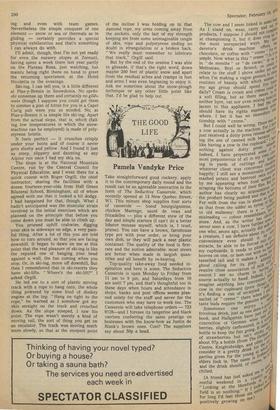SPORTING LIFE
Clive Gammon
I have just realised that by starting to write this piece I have put myself in an extremely vulnerable position vis-à-vis Mr Avery Brundage who has been sorting out the Sapporo ski-ers in no mean style lately. And so early in my ski-ing career, too! It was only a week or two since that for the first time I clamped on a pair of those huge boots that make you look like Pinocchio and painfully stomped to the beginners' class. And now my amateur status is gone forever. I just hope that Mr W. H. Clement, the secretary of the Welsh Rugby Union, isn't reading this: he might cancel my debenture seat at Cardiff Arms Park, It's a tough world, being a pro.
But back to ski-ing, Although I was not amongst the, no doubt, several hundred people who watched the Winter Olympics in Japan on television with avid interest, since to me one bob-sled run looks identical to the next and I get no pleasure from watching living billboards, (yes, you are quite right, Mr Brundage) slaloming around flag-poles, I must concede that ski-ing looks a pleasant activity to take part in.
Limited, of course, like surf-board riding or dinghy-sailing or skating, because there is insufficient complexity compared with real sports like fly-fishing or rough shoot ing and even with team games. Nevertheless the simple conquest of one element — snow or sea or thermals as in gliding — certainly provides a special physical exhilaration and that's something I can always do with.
I'll admit, though, that I'm not yet ready for even the nursery slopes at Zermatt, having spent a week there last year partly on the Plateau Rosa, just watching, but mainly being right there on hand to greet the returning sportsmen at the Hotel Nicoletta in the evenings.
Ski-ing, I can tell you, is a little different at Plas-y-Brenin in Snowdonia. No apresski nonsense up there and certainly no g/tihwein though I suppose you could get them to simmer a pint of bitter for you in a Cape! Curig pub were you so minded. No, at Plas-y-Brenin it is simple life ski-ing. Apart from the actual slope, that is, which (failing low temperatures in which the snowmachine can be employed) is made of polystyrene bristle.
It feels perfect — it crunches crisply under your boots and of course it never gets slushy and yellow. And I found it just as steep, slippery and daunting as any Alpine run once I had my skis on.
The slope is at the National Mountain Centre, run by the Central Council for Physical Education, and I went there for a quick course with Roger Orgill, the chief instructor, sharing the facilities with a dozen fourteen-year-olds from Hall Green Bilateral School, Birmingham, all of whom agreed with me that it looked a bit dodgy.
had bargained for that, though. What I hadn't anticipated was the muscular strain involved in the initial exercises which are planned on the principle that before you come down you must be able to climb up.
You proceed uphill crabwise, digging your skis in sideways on edge, a very painful thing. After a lot of this you are told how to turn around, so that you are facing downhill. It began to dawn on me at this point that the real pleasure of ski-ing is like the reputed one of banging your head against a wall, the fun coming when you stop. Or, in ski-ing, move off downhill, But then I remembered that in ski-resorts they have ski-lifts. "Where's the ski-lift?" I asked Orgill.
He led me to a sort of plastic moving track with a rope to hang onto, the whole thing powered by some kind of donkey engine at the top. "Hang on tight to the rope," he warned as I somehow got my skis straight on the track and crouched down. As the slope steeped, I saw his point. The rope wasn't merely a kind of moving rail, the sort of thing you get on an escalator. The track was moving much more slowly, so that at the steepest point of the incline I was holding on to that damned rope, my arms coming away from the sockets, only the last of my strength keeping me from some unimaginable tangle of skis, rope and polystyrene ending no doubt in strangulation or a broken back. "We really must remember to lubricate that track," Orgill said.
But by the end of the session I was able to glissade, if that's the right word, down maybe 200 feet of plastic snow and apart from the residual aches and cramps in feet and arms I was even beginning to enjoy it. Ask me sometime about the snow-plough technique or any other little point like that. I'd be glad to help out.











































 Previous page
Previous page